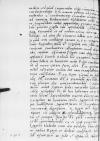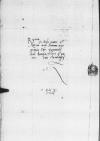Letter #3384
Martin ALLEXWANGEN to Ioannes DANTISCUSCracow (Kraków), 1548-06-29
| received Heilsberg (Lidzbark Warmiński), 1548-07-10 Manuscript sources:
| ||||
Text & apparatus & commentary Plain text Text & commentary Text & apparatus
Reverendissimo in Christo Patri et Domino, domino
Reverendissime in Christo Pater et Domine, domine benefactor et patrone clementissime.
Praemissa officiosissima servitute in gratiam Reverendissimae Paternitatis Vestrae.
Salutem plurimam et fortunatissimas accessiones.
Reverendissime Domine.
Quae sint merita et beneficia tam erga me, quam meos omnes in conferenda eiusdem Reverendissimae Paternitatis Vestrae opera, consilio et labore semper apud nos veteris stabit gratia facti, dum memores erimus nostri et quoad spiritus nostros reget artus. Cum vero per fortunae nostrae exiguitatem, quae quanta sit, plus satis Reverendissimae Paternitati Vestrae constat, referre non datur occasio, vitam nobis acerbam putamus. Ut etiamsi sanguinem pro Reverendissima Paternitate Vestra effunderemus, tamen neutiquam ullam beneficiorum partem assecuti videremur, tanta sunt Reverendissimae Paternitatis Vestrae erga nos merita. Quodsi ita aliquando res sese obtulerit de familia Reverendissimae Paternitatis Vestrae benemereri, non deerimus opera nostra, ut saltem aliquem de nobis demus gustum Paternitati Vestrae Reverendissimae, ne ullum beneficii genus sentiat interiisse. Quam iustus enim et aequus fuerit et habitus semper est iudex in dirimendis controversiis, non in praesenti hoc, quam in praeterito etiam facto plus satis constat, deque hoc aliorum sit iudicium, cum absque dubio Reverendissima Paternitas Vestra non exiguum mercedis praemium a Deo Optimo Maximo sit acceptura.
Quae porro Reverendissima Paternitas Vestra scribit et me adhortatur (quandoquidem animus hominis novarum rerum semper est cupidus), ut si quae apud nos essent novitates, eas cum Reverendissima Paternitate Vestra communicarem, faciam pro officio meo, ut ante factum a me quoque est, non quod certo sciam eas sic accidisse, sed quod frequentibus vulgi rumoribus sic circumferantur.
Ex
Inter
Ex
Legatus
Legati designati sunt: ad
Illustres et magnifici domini
Exsequiae peragentur ad diem divae Annae sacrum. Multorum principum et legatorum congregationem futuram opinor, qui praesentia sua exsequias easdem cohonestabunt.
Plura non habeo, nisi ut quam humillime etiam atque etiam in gratiam Reverendissimae Paternitatis Vestrae me commendem. Quam ut Deus Optimus Maximus in multos annos felicem esse ac vivere permittat, ex animo precor.
Datae
Eiusdem Reverendissimae Paternitatis Vestrae humillimus addictissimusque cliens



